Abstract
Class I major histocompatibility antigens in humans (HLA antigens) were found to participate in the regulation of T-cell activation and proliferation induced by phytohemagglutinin. W6/32, a monomorphic antibody directed against class I HLA-A,B,C antigens, significantly inhibited the phytohemagglutinin-induced cell proliferation of peripheral blood lymphocytes. Almost complete suppression of cell activation was achieved on a subfraction of peripheral blood lymphocytes enriched in Mo1+ monocyte/macrophage cells. This inhibition of cell proliferation takes place at an early stage of activation and was found to be adherent cell dependent. Removal of monocyte/macrophage type cells from peripheral blood lymphocytes completely abrogated the inhibitory influence of anti-HLA-class I antibody, and, upon adding them back, suppression reappeared. Indirect immunofluorescence demonstrated that the expression of receptors for interleukin 2 and transferrin was impaired in the presence of antibody. Although the amount of interleukin 2 synthesized by these cells was also reduced, the addition of exogenous purified interleukin 2 did not restore cell proliferation. Mitogenesis induced by the Ca2+ ionophore A23187 was similarly suppressed, but mitogenesis induced by the phorbol diester phorbol myristate acetate, which activates cells by directly stimulating protein kinase C, was not suppressed. These results are consistent with a hypothesis that HLA class I antigens regulate an early event(s) of the Ca2+-dependent pathway of activation of T lymphocytes and that this event(s) apparently occurs before protein kinase C stimulation.
Full text
PDF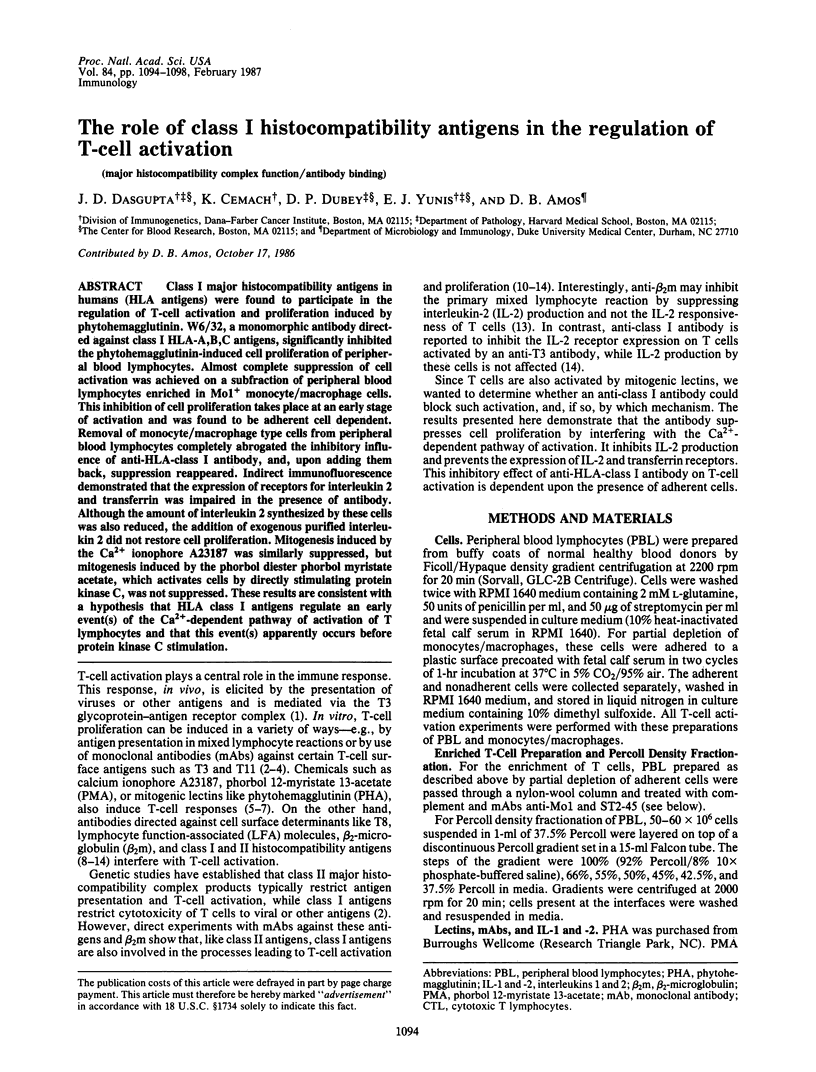
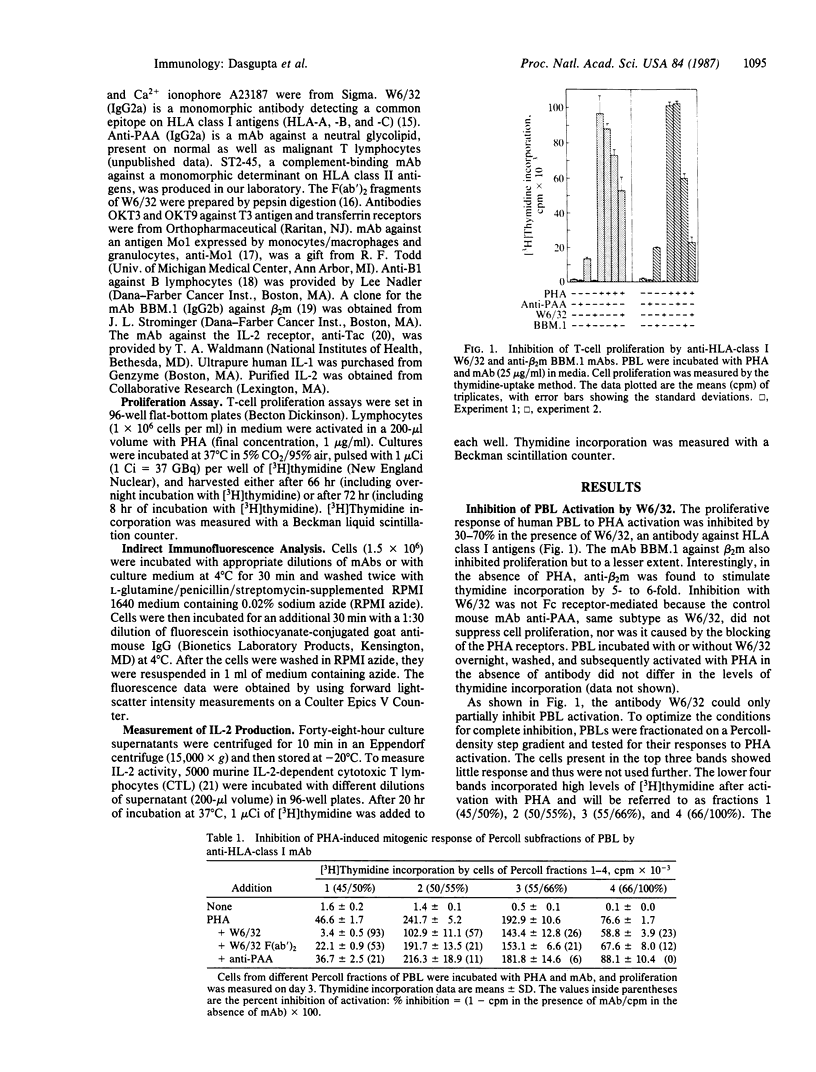
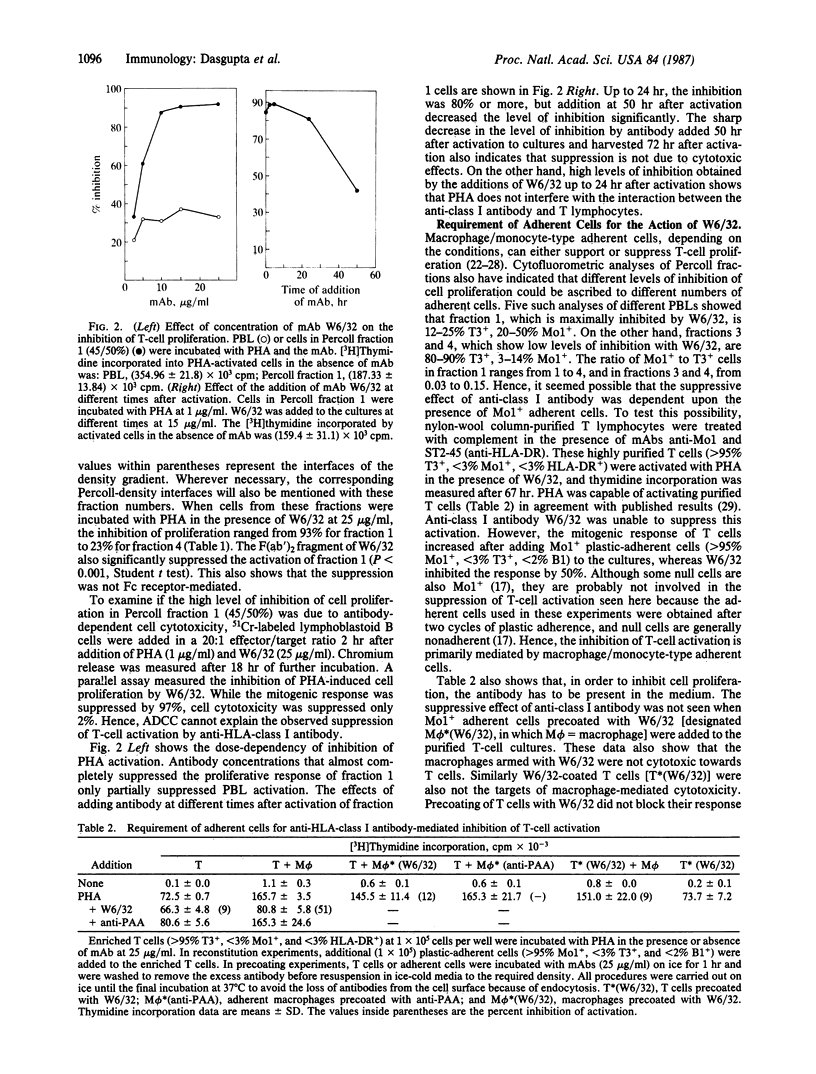
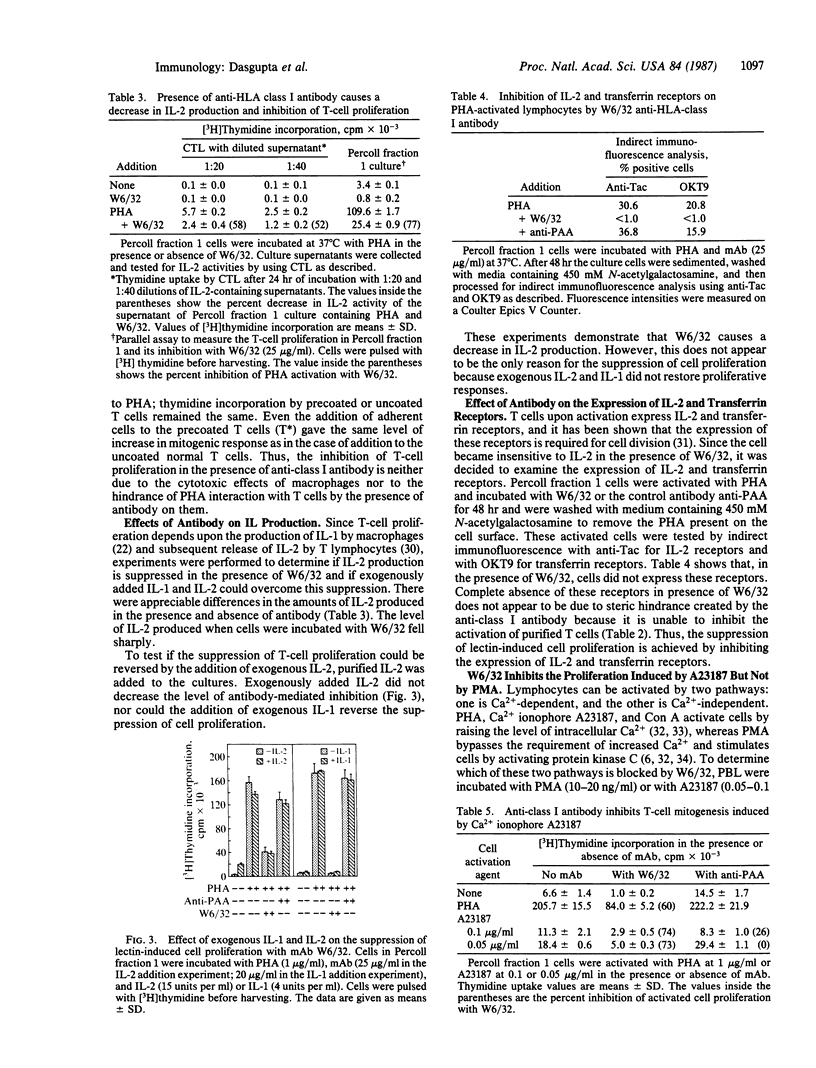
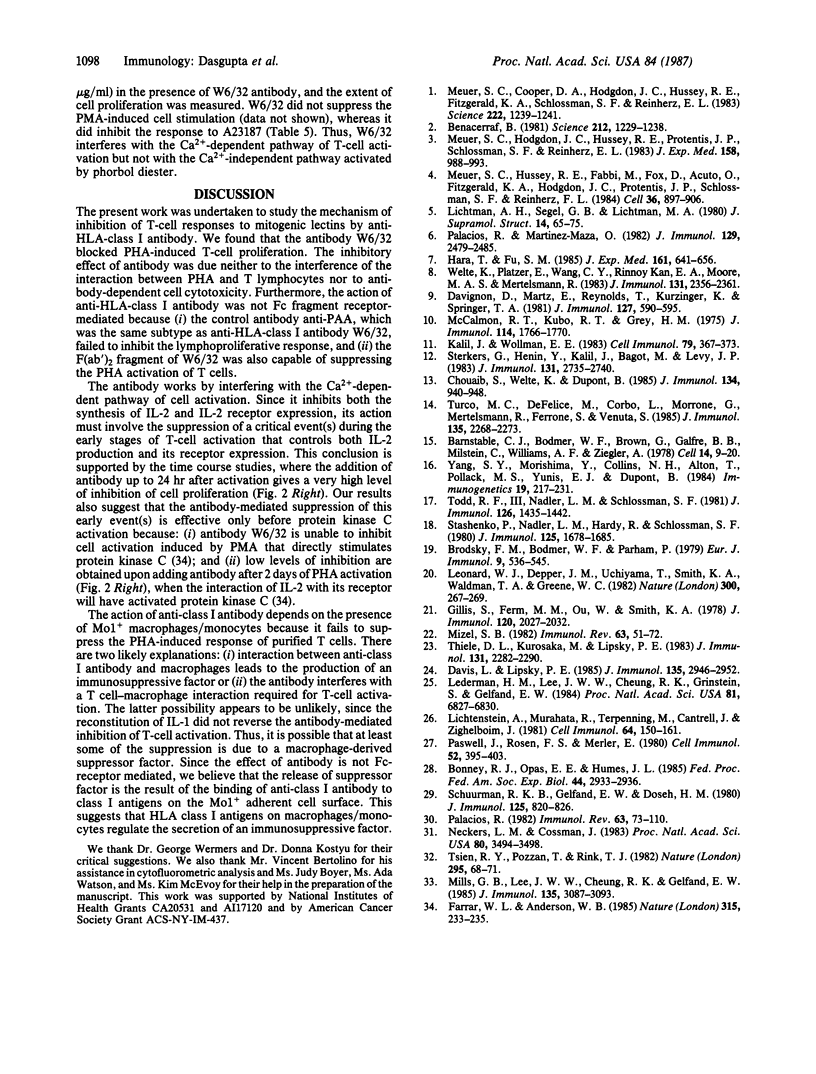
Selected References
These references are in PubMed. This may not be the complete list of references from this article.
- Barnstable C. J., Bodmer W. F., Brown G., Galfre G., Milstein C., Williams A. F., Ziegler A. Production of monoclonal antibodies to group A erythrocytes, HLA and other human cell surface antigens-new tools for genetic analysis. Cell. 1978 May;14(1):9–20. doi: 10.1016/0092-8674(78)90296-9. [DOI] [PubMed] [Google Scholar]
- Benacerraf B. Role of MHC gene products in immune regulation. Science. 1981 Jun 12;212(4500):1229–1238. doi: 10.1126/science.6165083. [DOI] [PubMed] [Google Scholar]
- Bonney R. J., Opas E. E., Humes J. L. Lipoxygenase pathways of macrophages. Fed Proc. 1985 Nov;44(14):2933–2936. [PubMed] [Google Scholar]
- Brodsky F. M., Bodmer W. F., Parham P. Characterization of a monoclonal anti-beta 2-microglobulin antibody and its use in the genetic and biochemical analysis of major histocompatibility antigens. Eur J Immunol. 1979 Jul;9(7):536–545. doi: 10.1002/eji.1830090709. [DOI] [PubMed] [Google Scholar]
- Chouaib S., Welte K., Dupont B. Differential effect of anti-beta 2-microglobulin on IL 2 production and IL 2 receptor expression in the primary mixed lymphocyte culture reaction. J Immunol. 1985 Feb;134(2):940–948. [PubMed] [Google Scholar]
- Davignon D., Martz E., Reynolds T., Kürzinger K., Springer T. A. Monoclonal antibody to a novel lymphocyte function-associated antigen (LFA-1): mechanism of blockade of T lymphocyte-mediated killing and effects on other T and B lymphocyte functions. J Immunol. 1981 Aug;127(2):590–595. [PubMed] [Google Scholar]
- Davis L., Lipsky P. E. Signals involved in T cell activation. I. Phorbol esters enhance responsiveness but cannot replace intact accessory cells in the induction of mitogen-stimulated T cell proliferation. J Immunol. 1985 Nov;135(5):2946–2952. [PubMed] [Google Scholar]
- Farrar W. L., Anderson W. B. Interleukin-2 stimulates association of protein kinase C with plasma membrane. Nature. 1985 May 16;315(6016):233–235. doi: 10.1038/315233a0. [DOI] [PubMed] [Google Scholar]
- Gillis S., Ferm M. M., Ou W., Smith K. A. T cell growth factor: parameters of production and a quantitative microassay for activity. J Immunol. 1978 Jun;120(6):2027–2032. [PubMed] [Google Scholar]
- Hara T., Fu S. M. Human T cell activation. I. Monocyte-independent activation and proliferation induced by anti-T3 monoclonal antibodies in the presence of tumor promoter 12-o-tetradecanoyl phorbol-13 acetate. J Exp Med. 1985 Apr 1;161(4):641–656. doi: 10.1084/jem.161.4.641. [DOI] [PMC free article] [PubMed] [Google Scholar]
- Kalil J., Wollman E. E. Role of class I and class II antigens in the allogenic stimulation: class I and class II recognition in allogenic stimulation; blocking of MLR by monoclonal antibodies and F(ab')2 fragments. Cell Immunol. 1983 Jul 15;79(2):367–373. doi: 10.1016/0008-8749(83)90078-3. [DOI] [PubMed] [Google Scholar]
- Lederman H. M., Lee J. W., Cheung R. K., Grinstein S., Gelfand E. W. Monocytes are required to trigger Ca2+ uptake in the proliferative response of human t lymphocytes to staphylococcus aureus protein A. Proc Natl Acad Sci U S A. 1984 Nov;81(21):6827–6830. doi: 10.1073/pnas.81.21.6827. [DOI] [PMC free article] [PubMed] [Google Scholar]
- Leonard W. J., Depper J. M., Uchiyama T., Smith K. A., Waldmann T. A., Greene W. C. A monoclonal antibody that appears to recognize the receptor for human T-cell growth factor; partial characterization of the receptor. Nature. 1982 Nov 18;300(5889):267–269. doi: 10.1038/300267a0. [DOI] [PubMed] [Google Scholar]
- Lichtenstein A., Murahata R., Terpenning M., Cantrell J., Zighelboim J. Activation and mechanism of action of suppressor macrophages. Cell Immunol. 1981 Oct;64(1):150–161. doi: 10.1016/0008-8749(81)90466-4. [DOI] [PubMed] [Google Scholar]
- Lichtman A. H., Segel G. B., Lichtman M. A. Total and exchangeable calcium in lymphocytes: effects of PHA and A23187. J Supramol Struct. 1980;14(1):65–75. doi: 10.1002/jss.400140107. [DOI] [PubMed] [Google Scholar]
- McCalmon R. T., Kubo R. T., Grey H. M. Effect of anti-beta2-microglobulin on antigen and allogeneic lymphocyte-induced proliferation of human lymphocytes. J Immunol. 1975 Jun;114(6):1766–1770. [PubMed] [Google Scholar]
- Meuer S. C., Cooper D. A., Hodgdon J. C., Hussey R. E., Fitzgerald K. A., Schlossman S. F., Reinherz E. L. Identification of the receptor for antigen and major histocompatibility complex on human inducer T lymphocytes. Science. 1983 Dec 16;222(4629):1239–1242. doi: 10.1126/science.6606228. [DOI] [PubMed] [Google Scholar]
- Meuer S. C., Hodgdon J. C., Hussey R. E., Protentis J. P., Schlossman S. F., Reinherz E. L. Antigen-like effects of monoclonal antibodies directed at receptors on human T cell clones. J Exp Med. 1983 Sep 1;158(3):988–993. doi: 10.1084/jem.158.3.988. [DOI] [PMC free article] [PubMed] [Google Scholar]
- Meuer S. C., Hussey R. E., Fabbi M., Fox D., Acuto O., Fitzgerald K. A., Hodgdon J. C., Protentis J. P., Schlossman S. F., Reinherz E. L. An alternative pathway of T-cell activation: a functional role for the 50 kd T11 sheep erythrocyte receptor protein. Cell. 1984 Apr;36(4):897–906. doi: 10.1016/0092-8674(84)90039-4. [DOI] [PubMed] [Google Scholar]
- Mills G. B., Lee J. W., Cheung R. K., Gelfand E. W. Characterization of the requirements for human T cell mitogenesis by using suboptimal concentrations of phytohemagglutinin. J Immunol. 1985 Nov;135(5):3087–3093. [PubMed] [Google Scholar]
- Mizel S. B. Interleukin 1 and T cell activation. Immunol Rev. 1982;63:51–72. doi: 10.1111/j.1600-065x.1982.tb00411.x. [DOI] [PubMed] [Google Scholar]
- Neckers L. M., Cossman J. Transferrin receptor induction in mitogen-stimulated human T lymphocytes is required for DNA synthesis and cell division and is regulated by interleukin 2. Proc Natl Acad Sci U S A. 1983 Jun;80(11):3494–3498. doi: 10.1073/pnas.80.11.3494. [DOI] [PMC free article] [PubMed] [Google Scholar]
- Palacios R., Martinez-Maza O. Is the E receptor on human T lymphocytes a "negative signal receptor"? J Immunol. 1982 Dec;129(6):2479–2485. [PubMed] [Google Scholar]
- Palacios R. Mechanism of T cell activation: role and functional relationship of HLA-DR antigens and interleukins. Immunol Rev. 1982;63:73–110. doi: 10.1111/j.1600-065x.1982.tb00412.x. [DOI] [PubMed] [Google Scholar]
- Passwell J., Rosen F. S., Merler E. The effect of Fc fragments of IgG on human mononuclear cell responses. Cell Immunol. 1980 Jul 1;52(2):395–403. doi: 10.1016/0008-8749(80)90360-3. [DOI] [PubMed] [Google Scholar]
- Schuurman R. K., Gelfand E. W., Dosch H. M. Polyclonal activation of human lymphocytes in vitro. I. Characterization of the lymphocyte response to a T cell-independent B cell mitogen. J Immunol. 1980 Aug;125(2):820–826. [PubMed] [Google Scholar]
- Stashenko P., Nadler L. M., Hardy R., Schlossman S. F. Characterization of a human B lymphocyte-specific antigen. J Immunol. 1980 Oct;125(4):1678–1685. [PubMed] [Google Scholar]
- Sterkers G., Henin Y., Kalil J., Bagot M., Levy J. P. Influence of HLA class I- and class II-specific monoclonal antibodies on DR-restricted lymphoproliferative responses. I. Unseparated populations of effector cells. J Immunol. 1983 Dec;131(6):2735–2740. [PubMed] [Google Scholar]
- Thiele D. L., Kurosaka M., Lipsky P. E. Phenotype of the accessory cell necessary for mitogen-stimulated T and B cell responses in human peripheral blood: delineation by its sensitivity to the lysosomotropic agent, L-leucine methyl ester. J Immunol. 1983 Nov;131(5):2282–2290. [PubMed] [Google Scholar]
- Todd R. F., 3rd, Nadler L. M., Schlossman S. F. Antigens on human monocytes identified by monoclonal antibodies. J Immunol. 1981 Apr;126(4):1435–1442. [PubMed] [Google Scholar]
- Tsien R. Y., Pozzan T., Rink T. J. T-cell mitogens cause early changes in cytoplasmic free Ca2+ and membrane potential in lymphocytes. Nature. 1982 Jan 7;295(5844):68–71. doi: 10.1038/295068a0. [DOI] [PubMed] [Google Scholar]
- Turco M. C., De Felice M., Corbo L., Morrone G., Mertelsmann R., Ferrone S., Venuta S. Regulatory role of a monomorphic determinant of HLA Class I antigens in T cell proliferation. J Immunol. 1985 Oct;135(4):2268–2273. [PubMed] [Google Scholar]
- Welte K., Platzer E., Wang C. Y., Rinnooy Kan E. A., Moore M. A., Mertelsmann R. OKT8 antibody inhibits OKT3-induced IL 2 production and proliferation in OKT8+ cells. J Immunol. 1983 Nov;131(5):2356–2361. [PubMed] [Google Scholar]
- Yang S. Y., Morishima Y., Collins N. H., Alton T., Pollack M. S., Yunis E. J., Dupont B. Comparison of one-dimensional IEF patterns for serologically detectable HLA-A and B allotypes. Immunogenetics. 1984;19(3):217–231. doi: 10.1007/BF00364765. [DOI] [PubMed] [Google Scholar]


